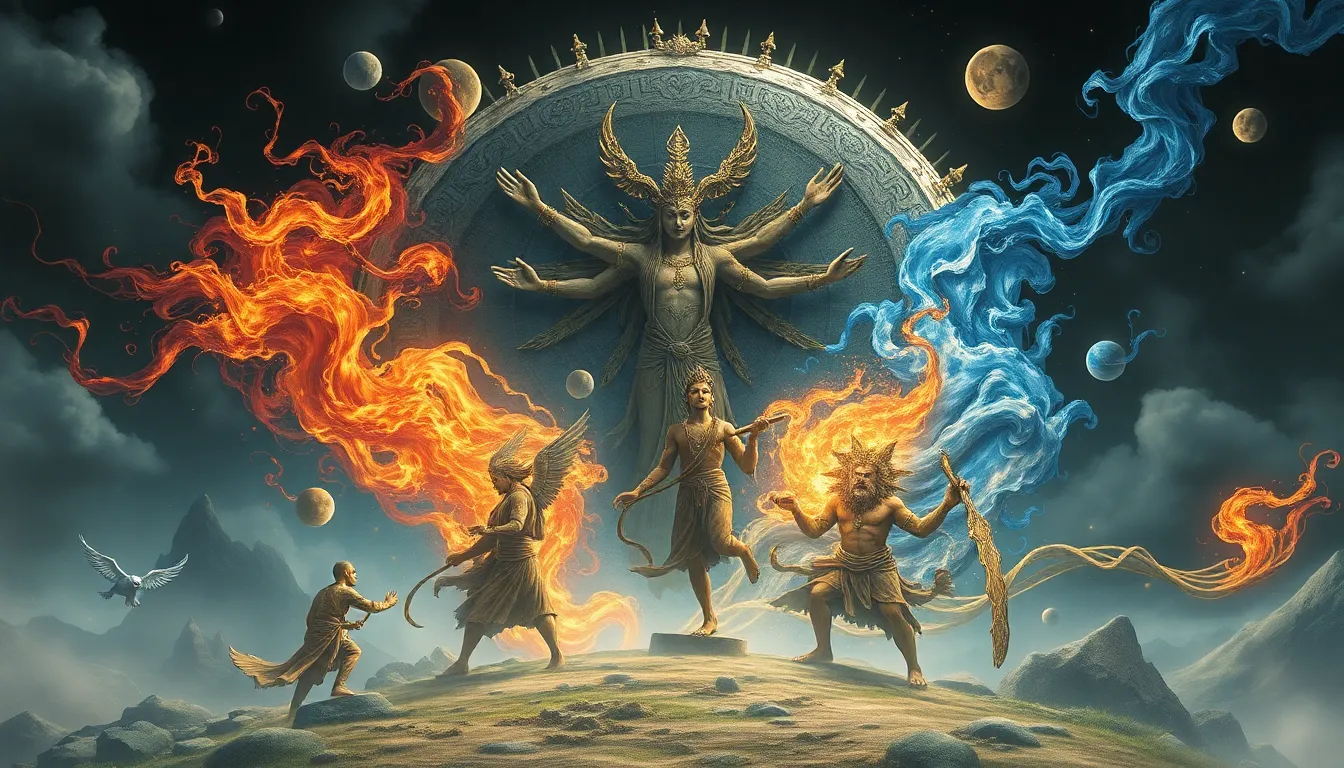The Tale of Chandra: The Moon God in Hindu Mythology
I. Introduction: Chandra in Hindu Mythology
In the vast tapestry of Hindu mythology, Chandra stands as a celestial deity who governs the moon and its multifaceted cycles. As the Lord of the Night, he illuminates the celestial expanse with his ethereal glow and profoundly influences the rhythm of life on Earth. From time immemorial, Chandra has held a significant place in the hearts and minds of Hindus, shaping their beliefs, rituals, and cultural expressions.
II. Birth and Origin of Chandra
Chandra's genesis is shrouded in cosmic legends. It is believed that he emerged from the churning of the primordial ocean of milk, along with the celestial physician Dhanvantari and the elixir of immortality, Amrita. As the son of Atri, a renowned sage, and Anasuya, a pious wife, Chandra inherited divine attributes that made him the embodiment of the moon's gentle radiance and tranquil nature.
III. Chandra's Association with the Moon
Chandra's inextricable connection with the moon is central to his identity and symbolism. As the celestial ruler of the lunar sphere, he orchestrates the waxing and waning of the moon, marking the passage of time and influencing human affairs. The luminosity of his orb is seen as a manifestation of his wisdom, while the ebb and flow of its phases symbolize the cyclical nature of existence.
IV. The Lunar Cycle and Its Significance
The lunar cycle, governed by Chandra, holds immense significance in Hindu tradition. The waxing moon, Sukla Paksha, is associated with growth, prosperity, and auspicious beginnings. Conversely, the waning moon, Krishna Paksha, represents completion, release, and the dissolution of negativity. Hindus observe specific rituals and festivals during each phase to align themselves with the cosmic rhythms governed by Chandra.
V. Chandra's Marriage and Family
Chandra's marital life is an intricate tapestry of love, passion, and divine intervention. He is said to have married 27 daughters of Prajapati Daksha, who are collectively known as the Nakshatras or lunar mansions. However, his partiality towards Rohini, one of the Nakshatras, led to a conflict with his father-in-law, resulting in a curse that temporarily diminished Chandra's luminosity.
VI. Chandra's Role as a Deity of Time and Measurement
As the celestial timekeeper, Chandra governs the passage of time and the measurement of its duration. Hindus mark the beginning of each month based on the position of the moon in relation to the stars, creating a lunar calendar that synchronizes human activities with cosmic rhythms. Vedic scriptures associate Chandra with Tithi, the lunar day, and Nakshatra, the lunar mansion, providing a framework for calculating auspicious moments and observing religious ceremonies.
VII. Chandra's Influence on Human Affairs
Chandra's influence extends far beyond celestial bodies, shaping human affairs in numerous ways. Traditional Hindu astrology attributes certain personality traits, strengths, and challenges to individuals based on the position of the moon at the time of their birth. The moon's phases are also believed to affect mental and emotional well-being, guiding individuals towards introspection, self-awareness, and emotional healing.
VIII. Chandra's Worship and Rituals
In Hindu tradition, Chandra is revered through various rituals and observances. Mondays, known as Chandravar, are considered particularly auspicious for worshiping Chandra. Devotees offer prayers, light ghee lamps, and chant mantras dedicated to the moon god. Specific festivals, such as Kartik Purnima and Chandra Grahan (lunar eclipse), hold special significance for Chandra worshipers. These rituals seek to honor the moon god's divine grace and invoke his blessings for peace, harmony, and spiritual growth.
IX. Chandra in Art and Literature
Chandra's celestial beauty and enigmatic nature have inspired countless works of art and literature throughout history. In Hindu iconography, Chandra is often depicted as a fair-complexioned deity, adorned with a crescent moon on his forehead and riding a silver chariot drawn by white horses. Poets and writers have woven tales of Chandra's love, his conflicts with other deities, and his role in cosmic events, enriching the tapestry of Hindu mythology.
X. Conclusion: The Enduring Legacy of Chandra
Across centuries and civilizations, Chandra has remained an enduring symbol of celestial radiance, timekeeping, and human emotions. His influence permeates various aspects of Hindu culture, from religious observances to storytelling and even daily life. As the Lord of the Night, Chandra continues to illuminate the path of humanity, guiding us through the ebb and flow of life's cycles with his gentle grace and illuminating wisdom.
FAQ
Q: What is Chandra's relationship with the planet Moon?
A: Chandra is the Hindu deity who personifies the Moon. He governs the celestial sphere of the moon and influences its phases, cycles, and effects on human affairs.
Q: Why is Chandra associated with Mondays?
A: In Hindu tradition, Monday (Chandravar) is considered particularly auspicious for worshiping Chandra. Devotees believe that offering prayers and performing rituals on this day brings blessings, peace, and harmony.
Q: How is Chandra depicted in Hindu art?
A: Chandra is typically portrayed as a fair-complexioned deity with a crescent moon on his forehead. He is often depicted riding a silver chariot drawn by white horses, symbolizing his celestial nature.
Q: What is the significance of the lunar cycle in Hindu tradition?
A: The lunar cycle, governed by Chandra, holds immense significance. The waxing moon (Sukla Paksha) is associated with growth and auspicious beginnings, while the waning moon (Krishna Paksha) represents completion and release. Rituals and festivals are observed during specific phases to align with cosmic rhythms.
Q: How does Chandra influence human emotions?
A: The position of the moon at the time of birth and its phases are believed to influence an individual's personality traits, emotions, and mental well-being. Chandra's energy is associated with introspection, self-awareness, and emotional healing.



